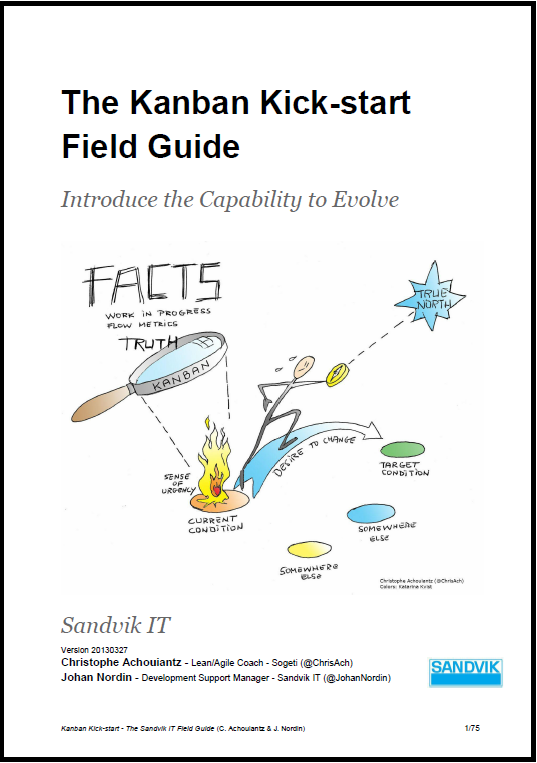Here is a teaser for “The Kanban Kick-start Field Guide“.
The document is almost ready by now, with some minor work left on the boosts in the “After the Kick-start” chapter. And, yes, there is a section about Depth of Kanban in there.
 |
| The Cover of the book (it may change) |
Key Aspects
Due to our constraints (few coaches for many teams, focus on evolution rather than direct better flow) the Kanban Kick-start has developed the following aspects that may differ from other ways/methods/processes for introducing Kanban:
-
The team is the driver. The coach is simply helping the team to set its kanban system in place.
-
In its purest approach, the coach does not design the kanban system for the team, the team does it. This may not become an optimal kanban system, but this is not the goal (yet).
-
The goal is to increase the team’s understanding about itself and its context so that it can evolve by itself and become what it must.
-
At the end of the workshop, the team has a visualization board, explicit work policies and a way-of-working with the board.
-
The workshop, the board and the policies are for the team and by the team.
-
The agenda of the Kick-start is modular to fit teams with different maturity.
-
The Kanban Kick-start is packaged in such a way to be easily “sold” to managers under stress: It is a one day workshop with the whole team (6-8 hours).
-
Not everything actually happens during one day, some preparation are required before the workshop with the manager and team-lead.
-
The coach is also required to follow-up the team after the workshop to: a) help the team implement the kanban concepts that didn’t stick during the workshop (or that were left out), and b) make sure that the team can sustain its kanban system (by adapting the system or coaching the team).
Table of Contents
The current table of content looks like this:
The Kick-start Concept
What is the Kanban Kick-start?
History of the Kanban Kick-start at Sandvik IT
Key Aspects
An Evolution Process
A Kick-starting Process
The Goal: Reach Baseline
The Kick-start
How-To
Before the Kick-start: Understand the Team
Key Players
PREP 1: Present Kanban as a Tool for Evolution
PREP 2: Understand the Team’s Needs
PREP 3: Set Expectations
PREP 4: Prepare the Team-Lead
Before the Kick-start: Plan the Workshop
SETUP 1: Create an Agenda
SETUP 2: Setup the Workshop
SETUP 3: Extra Preparations for a Distributed Team
Run The Kick-start Workshop
KICK 1: Set the Scene
KICK 2: Understand Current Concerns
KICK 3: Define the Team’s Purpose
KICK 4: Discover what the Team Does
KICK 5: Identify Work Types
KICK 6: Explain How the Board Works
KICK 7: Present a Common Language
KICK 8: Set Visualization Policies
KICK 9: Create & Populate the Board
KICK 10: Set Way-of-Working Policies
KICK 11: Limit WIP
KICK 12: Set Planning Meetings Policies
KICK 13: Run the First Planning Meeting
KICK 14: Close the Scene
After the Kick-start: Reach a Baseline
BOOST 1: Adjust Planning Meetings
BOOST 2: Adapt
BOOST 3: Measure Flow
BOOST 4: Limit WIP
BOOST 5: Set Policies for Demand Management
BOOST 6: Assess Depth of Kanban
BOOST 7: Set Next Target Condition
BOOST 8: Give Feedback on the Field Guide
Frequently Ask Questions (FAQ)
References
Glossary of Frequently Used Terms
The kick-starting “process” is very visible in the Table of Content.
Intrigued?
Check back soon for the real stuff!



